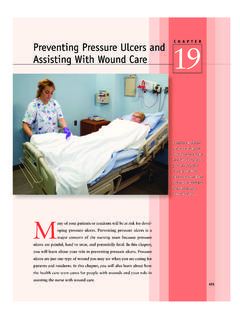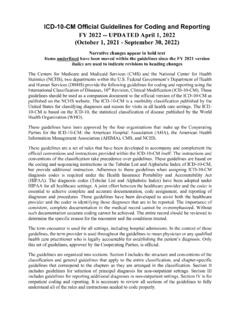Transcription of Inpatient Rehabilitation Facility Patient Assessment ...
1 Inpatient Rehabilitation Facility Patient Assessment Instrument (IRF-PAI). Quarterly Q&As March 2022. Consolidated June 2020 to March 2022. Introduction The Centers for Medicare & Medicaid Services (CMS) is publishing the Inpatient Rehabilitation Facility Patient Assessment Instrument (IRF-PAI) Quarterly Q&As, so that all IRF providers have the benefit of the clarifications to existing guidance. Through inquiries to the IRF Post-Acute Care (PAC) Quality Reporting Program (QRP) Help Desk, CMS identifies the opportunity to clarify or refine guidance.
2 New Q&As Added in March 2022. 1. 44D. Question 2. 2. GG0170N, GG0170O. Question 3. This document is intended to provide guidance on IRF-PAI questions that were received by CMS help desks. Responses contained in this document may be superseded by guidance published by CMS at a later date. IRF-PAI Quarterly Q&As, March 2022, Consolidated June 2020 to March 2022 Page i of iii Consolidated Table of Contents Introduction .. i New Q&As Added in March 2022 .. i Quality Indicators (QI): General Questions .. 1. section A: Administrative Information.
3 2. 25A, 26A .. 2. 25A .. 2. 44D .. 3. section C: Cognitive Patterns .. 4. Brief Interview for Mental Status (BIMS) C0100, C0200, C0300, C0400, C0500 .. 4. section GG: Functional Abilities and Goals .. 5. GG0100C .. 5. GG0100C, GG0170M, GG0170N, GG0170O .. 5. GG0100, GG0110 .. 6. GG0110 .. 6. GG0130, GG0170 .. 7. GG0130A .. 12. GG0130B .. 13. GG0130C .. 14. GG0130E .. 15. GG0130F, GG0130G, 17. GG0130G, 18. GG0130G .. 18. GG0130H .. 18. GG0170 .. 20. GG0170C .. 21. GG0170E .. 21. GG0170F .. 22. GG0170G .. 23. GG0170I, GG0170J, GG0170K, 27.
4 GG0170I .. 28. GG0170M, GG0170N, GG0170O .. 29. This document is intended to provide guidance on IRF-PAI questions that were received by CMS help desks. Responses contained in this document may be superseded by guidance published by CMS at a later date. IRF-PAI Quarterly Q&As, March 2022, Consolidated June 2020 to March 2022 Page ii of iii 30. GG0170N, 31. GG0170P .. 32. GG0170Q .. 32. GG0170R, GG0170S .. 33. GG0170S .. 34. section H: Bladder and Bowel .. 35. H0350 .. 35. H0400 .. 36. section K: Swallowing/Nutritional Status.
5 37. K0110 .. 37. section M: skin conditions .. 38. M0210, M0300 .. 38. M0300 .. 38. section N: Medications .. 41. N2005 .. 41. This document is intended to provide guidance on IRF-PAI questions that were received by CMS help desks. Responses contained in this document may be superseded by guidance published by CMS at a later date. IRF-PAI Quarterly Q&As, March 2022, Consolidated June 2020 to March 2022 Page iii of iii Quality Indicators (QI): General Questions Question 1: If a Patient is admitted to an IRF on Monday but has to be transferred back to the acute care hospital the next day (Tuesday) and then returns to the IRF on Thursday, we know that this is considered a program interruption and the ARD date would be updated to reflect the days the Patient was not in the IRF.
6 Can we use Assessment information from Tuesday morning's functional assessments (the day the Patient returned to the acute care hospital) to code the admission QI items? Answer 1: If the Patient has a program interruption, the discharge date is not included as one of the 3 calendar days used to calculate the ARD, however the Assessment data gathered on the discharge date (the day the Patient is admitted to Acute Care from the IRF) may be used to code the admission QI items. At times CMS provides new or refined instruction that supersedes previously published guidance.
7 In such cases, use the most recent guidance. Added: June 2020. Question 2: In the latest Q&A release, there was a question that spoke to a decline with a Patient within the Assessment window with instructions to not update the Assessment with such. The example given was related to dysphagia following an ER stay. I am questioning now if we can identify other updates within the 3-day admission Assessment time period. Answer 2: Each IRF-PAI item should be considered individually, and coded based on the guidance provided for that item.
8 Unless otherwise specified in item guidance, information collected by the assessing clinician during the time period for the specified Assessment type may be used to inform IRF-PAI coding. Note that item guidance does specify special rules for coding pressure ulcer / injury and GG items at admission. To support consistency of data collection related to pressure ulcers and GG function data across all post-acute care (PAC) providers, cross-setting guidance directs coding for pressure ulcers/injuries to be based on the first skin Assessment and GG self-care and mobility items should be based on a functional Assessment that occurs at or soon after the Patient 's admission, and reflect the Patient 's baseline ability to complete the activity, prior to the benefit of services provided by your Facility staff.
9 Added: June 2021. This document is intended to provide guidance on IRF-PAI questions that were received by CMS help desks. Responses contained in this document may be superseded by guidance published by CMS at a later date. IRF-PAI Quarterly Q&As, March 2022, Consolidated June 2020 to March 2022 Page 1 of 41. section A: Administrative Information 25A, 26A. Question 1: When entering a Patient 's height and weight on admission for items 25A and 26A do the height and weight need to be measured while a Patient is in the Inpatient Rehabiliation Facility ?
10 Can they be estimated per Facility policies and procedures or can they be reported based on a height and weight obtained from documentation from another Facility ? Answer 1: The intent of item 25A - Height on admission is to record the Patient 's most recent height. The intent of item 26A - Weight on admission is to record the initial weight measuresment for the Patient . Only enter a height and weight that have been directly measured by your Facility staff. Do not enter a height or weight that is self-reported or derived from documentation from another provider setting.












